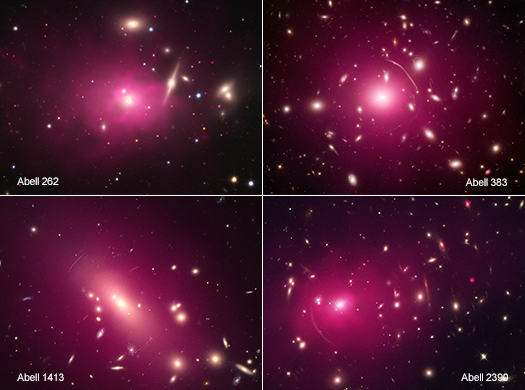
Four of the 13 galaxies clusters used in the study. The clusters are, starting at the top left and going clockwise, Abell 262, Abell 383, Abell 1413, and Abell 2390.
Astronomers have used data from NASA’s Chandra X-ray Observatory to study the properties of dark matter. The study, which involves 13 galaxy clusters, explores the possibility that dark matter may be more “fuzzy” than “cold,” perhaps even adding to the complexity surrounding this cosmic conundrum.
For several decades, astronomers have known about dark matter. Although it cannot be observed directly, dark matter does interact via gravity with normal, radiating matter (that is, anything made up of protons, neutrons, and electrons bundled into atoms). The effects of dark matter have been stuied using a variety of techniques, including observations of the motion of stars in galaxies, the motion of galaxies in galaxy clusters, and the distribution of Xray emitting hot gas in galaxy clusters. Dark matter has also left an imprint on the radiation left over from the Big Bang 13.8 billion years ago.
However, astronomers have been struggling for decades to understand the detailed properties of dark matter. The most popular model assumes that dark matter is a particle more massive than a proton that is “cold”, meaning that it moves at speeds much smaller than the speed of light. This model has been successful at explaining the structure of the universe on very large scales, much bigger than galaxies, but it has problems with explaining how matter is distributed on the smaller scales of galaxies. Eg. the cold dark matter model predicts that the density of dark matter in the center of galaxies is much higher than in surrounding regions close to the center. Because normal matter is attracted to the dark matter, it also should have a strong peak in density at the center of galaxies. However, astronomers observe that the density of both dark and normal matter in the center of galaxies is much more evenly spread out. Another issue with the cold dark matter model is that it predicts a much higher number of small galaxies orbiting around galaxies like the Milky Way than astronomers actually see.
To address these problems with the cold dark matter model, astronomers have come up alternative models where dark matter has very different properties. One such model takes advantage of the principle in quantum mechanics that each subatomic particle has a wave associated with it. If the dark matter particle has an extremely small mass, about 10,000 trillion trillion times smaller than an electron’s mass, its corresponding wavelength will be about 3,000 light years. This distance from one peak of the wave to another is ~1/8 of the distance between the Earth and the center of the Milky Way. By contrast, the longest wavelength of light, a radio wave, is only a few miles long.
Waves from different particles on these large scales can overlap and interfere with each other, acting like a quantum system on galactic rather than atomic scales. The large wavelength of the particles’ wave means that the density of dark matter in the center of galaxies cannot be strongly peaked. Therefore to an observer outside a galaxy these particles would appear fuzzy if they could be directly detected, so this model has been called “fuzzy dark matter”. As normal matter is attracted to the dark matter it will also be spread out over large scales. This would naturally explain the lack of a strong peak in the density of matter in the center of galaxies.
This simple model has been successful at explaining the amount and location of dark matter in small galaxies. For larger galaxies, a more complicated model of fuzzy dark matter has been needed. In this model, massive concentrations of dark matter can lead to multiple quantum states (called “excited states”), in which the dark matter particles can have different amounts of energy, similar to an atom with electrons in higher energy orbits. These excited states change how the density of dark matter varies with distance away from the center of the galaxy cluster. In a new study, a team used Chandra observations of hot gas in 13 galaxy clusters to see if the fuzzy dark matter model works at larger scales than that of galaxies. They estimated both the amount of dark matter in each cluster and how the density of this matter varies with distance away from the center of the galaxy cluster.
The graphic shows 4 of the 13 galaxies clusters used in the study. The clusters are, starting at the top left and going clockwise, Abell 262, Abell 383, Abell 1413, and Abell 2390. In each of these images, X-ray data from Chandra are pink, while optical data are red, green, and blue.
As with the studies of galaxies, the simplest model of fuzzy dark matter—where all particles have the lowest possible energy—did not agree with the data. However, they found that the model where the particles had different amounts of energy—the “excited states—did give good agreement with the data. In fact, the fuzzy dark matter model may match the observations of these 13 galaxy clusters just as well or even better than a model based on cold dark matter.
This result shows that the fuzzy dark matter model may be a viable alternative to cold dark matter, but further work is needed to test this possibility. An important effect of the excited states is to give ripples, or oscillations, in the density of dark matter as a function of distance away from the center of the cluster. This would produce ripples in the density of normal matter. The expected magnitude of these ripples is less than the current uncertainties in the data. A more detailed study is needed to test this prediction of the model.
http://chandra.harvard.edu/blog/node/642








Recent Comments